Artículos SCI
2021
2021
Materiales Ópticos Multifuncionales - Materiales Coloidales
Persistent luminescent nanoparticles: Challenges and opportunities for a shimmering future
Castaing, V.; Arroyo, E.; Becerro, A.I.; Ocaña, M.; Lozano, G.; Míguez, H.Journal of Applied Physics, 130 (2021) 080902 DOI: 10.1063/5.0053283
Abstract
Persistent phosphors are luminescent sources based on crystalline materials doped with rare-earth or transition metal cations able to produce light after the excitation source vanishes. Although known for centuries, these materials gained renewed interest after the discovery of Eu2+,RE3+ co-doped aluminates and silicates in the late 1990s due to their unprecedented afterglow properties. In contrast, persistent nanophosphors have emerged only recently as a nanoscale alternative to their bulk counterparts, offering exciting opportunities of particular relevance for in vivo imaging, optical data storage, or unconventional light generation. However, taking advantage of the avenues opened by nanoscience demands developing new synthetic strategies that allow precise control of the morphology, surface, and defect chemistry of the nanomaterials, along with a profound understanding of the physical mechanisms occurring in the nanoscale. Besides, advanced physicochemical characterization is required to assess persistent luminescence in a quantitative manner, which allows strict comparison among different persistent nanophosphors, aiming to propel their applicability. Herein, we revisit the main phenomena that determine the emission properties of persistent nanoparticles, discuss the most promising preparation and characterization protocols, highlight recent achievements, and elaborate on the challenges ahead.
Agosto, 2021 · DOI: 10.1063/5.0053283
Reactividad de Sólidos
Kinetics and cyclability of limestone (CaCO3) in presence of steam during calcination in the CaL scheme for thermochemical energy storage
Arcenegui-Troya, J; Sanchez-Jimenez, PE; Perejon, A; Moreno, V; Valverde, JM; Perez-Maqueda, LAChemical Engineering Journal, 417 (2021) 129194 DOI: 10.1016/j.cej.2021.129194
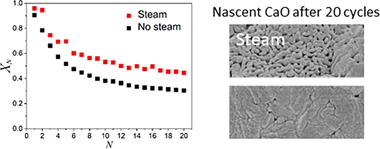
Abstract
In the present work, we explore the use of steam in the CaCO3 calcination step of the Calcium Looping process devised for thermochemical energy storage (CaL-TCES). Steam produces a double benefit: firstly, it fastens calcination, allowing a reduction of the temperature needed to attain full calcination in short residence times, as those required in practice, resulting in energy savings. This behaviour is justified on the basis of a kinetics study results obtained from a non-parametric kinetic analysis, which demonstrate that the presence of steam during calcination can reduce the apparent activation energy from 175 kJ/mol to 142 kJ/mol with a steam's partial pressure of 29%. In addition, the results obtained for multicycle CaL-TCES tests show that steam alleviates the deactivation of the sorbent, which is one of the main limiting factors of this technology. This behaviour is explained in terms of the effect of steam on the microstructure of the regenerated CaO. Importantly, the values of residual conversion attained by calcining in steam are higher than those without steam.
Agosto, 2021 · DOI: 10.1016/j.cej.2021.129194
Reactividad de Sólidos
Study of the Influence of Sintering Atmosphere and Mechanical Activation on the Synthesis of Bulk Ti2AlN MAX Phase Obtained by Spark Plasma Sintering
Salvo, C; Chicardi, E; García-Garrido, C; Poyato, R; Jimenez, JA; Mangalaraja, RVMaterials, 14 (2021) 4574 DOI: 10.3390/ma14164574
Abstract
The influence of the mechanical activation process and sintering atmosphere on the microstructure and mechanical properties of bulk Ti2AlN has been investigated. The mixture of Ti and AlN powders was prepared in a 1:2 molar ratio, and a part of this powder mixture was subjected to a mechanical activation process under an argon atmosphere for 10 h using agate jars and balls as milling media. Then, the sintering and production of the Ti2AlN MAX phase were carried out by Spark Plasma Sintering under 30 MPa with vacuum or nitrogen atmospheres and at 1200 degrees C for 10 min. The crystal structure and microstructure of consolidated samples were characterized by X-ray Diffraction, Scanning Electron Microscopy, and Energy Dispersive X-ray Spectroscopy. The X-ray diffraction patterns were fitted using the Rietveld refinement for phase quantification and determined their most critical microstructural parameters. It was determined that by using nitrogen as a sintering atmosphere, Ti4AlN3 MAX phase and TiN were increased at the expense of the Ti2AlN. In the samples prepared from the activated powders, secondary phases like Ti5Si3 and Al2O3 were formed. However, the higher densification level presented in the sample produced by using both nitrogen atmosphere and MAP powder mixture is remarkable. Moreover, the high-purity Ti2AlN zone of the MAX-1200 presented a hardness of 4.3 GPa, and the rest of the samples exhibited slightly smaller hardness values (4.1, 4.0, and 4.2 GPa, respectively) which are matched with the higher porosity observed on the SEM images.
Agosto, 2021 · DOI: 10.3390/ma14164574
Materiales Avanzados
Geopolymers made from metakaolin sources, partially replaced by Spanish clays and biomass bottom ash
Eliche-Quesada, D; Calero-Rodriguez, A; Bonet-Martinez, E;Perez-Villarejo, L; Sanchez-Soto, PJJournal of Building Engineering, 40 (2021) 102761 DOI: 10.1016/j.jobe.2021.102761
Abstract
The main objective of this investigation is to study the effect of the substitution of metakaolin (MK) (from calcined industrial kaolin) by four different calcined natural Southern Spain clays traditionally used in the brick and tile sector, as well as by the biomass bottom ash residue (BBA) from the combustion of a mix of olive and pine pruning on the synthesis of geopolymer with physical, mechanical and thermal properties comparable to those of classic construction materials. As alkaline activator, a 8 M solution of sodium hydroxide and sodium silicate have been used. Raw materials, metakaolin; Spanish clays: black clay (BC), yellow clay (YC), white clay (WC), red clay (RC) and BBA were characterized by chemical analysis (XRF), mineralogical analysis (XRD), and particle size analysis. Control geopolymers containing only metakaolin, and batch of geopolymers were formulated containing equal proportions of metakaolin, BBA and each of the four types of clay. After the curing period, at 60 degrees C for 1 day geopolymers were demolded and stored 27 days at room temperature. Geopolymers were characterized using Scanning Electron Microscopy coupled with Energy Dispersive Spectroscopy (SEM-EDS), XRD and Attenuated Total Reflectance-Fourier Transform Infrared Spec troscopy (ATR-FTIR). Their physical, mechanical and thermal properties have also been studied. The addition of BBA and different types of calcined clays to metakaolin gives rise to geopolymers with higher mechanical properties increasing the compressive strength of the control geopolymer containing only MK (24.9 MPa) by more than 50% for the GMK-BBA-WC geopolymers (38.5 MP a). The clays act as fillers and/or promote the precipitation of calcium-rich phases (Ca)-A-S-H-G gel that coexists with the (Na)-A-S-H gel type. The relevant results of physical, mechanical and thermal properties obtained in this research demonstrate the potential of Spanish clays and BBA as binders and substitutes for metakaolin.
Agosto, 2021 · DOI: 10.1016/j.jobe.2021.102761
Reactividad de Sólidos
Calcination under low CO2 pressure enhances the calcium Looping performance of limestone for thermochemical energy storage
Sarrion, B; Perejon, A; Sanchez-Jimenez, PE; Amghar, N; Chacartegui, R; Valverde, JM; Perez-Maqueda, LAChemical Engineering Journal, 417 (2021) 127922 DOI: 10.1016/j.cej.2020.127922
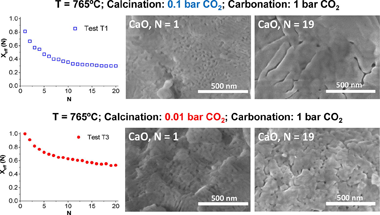
Abstract
The Calcium Looping performance of limestone for thermochemical energy storage has been investigated under novel favorable conditions, which involve calcination at moderate temperatures under CO2 at low pressure (0.01 and 0.1 bar) and carbonation at high temperature under CO2 at atmospheric pressure. Calcining at low CO2 pressures allows to substantially reduce the temperature to achieve full calcination in short residence times. Moreover, it notably enhances CaO multicycle conversion. The highest values of conversion are obtained for limestone samples calcined under 0.01 bar CO2 at 765 degrees C. Under these conditions, the residual conversion is increased by a factor of 10 as compared to conditions involving calcination under CO2 at atmospheric pressure. The enhancement of CaO conversion is correlated to the microstructure of the CaO samples obtained after calcination. As seen from SEM, BET surface and XRD analysis, calcination under low CO2 pressure leads to a remarkable decrease of pore volume and CaO crystallite size. Consequently, CaO surface area available for carbonation in the fast reaction-controlled regime and therefore reactivity in short residence times is promoted.
Agosto, 2021 · DOI: 10.1016/j.cej.2020.127922
Nanotecnología en Superficies y Plasma
Factors triggering germination in plasma-activated cotton seeds: water imbibition vs. reactive species' formation
Arroyo, E; De Navascues, P; Gómez-Ramírez, A; Molina, R; Perea, A; García, JL; Cotrino, J ; Cantos, M; González-Elipe, AR; López-Santos, CJournal of Physics D-Applied Physics, 54 (2021) 325205 DOI: 10.1088/1361-6463/abfefc
Abstract
Plasma technology has emerged as an efficient, simple, and eco-friendly method for activating seed germination processes. Most studies on this subject have focused on the morphological and wetting effects on the surface state of seeds and attributed the improvement in germination occasionally found to the induced hydrophilicity and a higher water imbibition rate. Recently, the involvement of reactive oxygen and nitrogen species in the germination process has also been highlighted. In this work, we study the effect of a very low-power cold atmospheric air-plasma treatment on the germination and sterilization of cotton seeds in normal (i.e., water abundant) and simulated drought conditions. Optical emission spectroscopy of the plasma has revealed the formation of different excited species of molecular nitrogen and oxygen, as well as OH and NO radicals that are deemed responsible for the chemical functionalization and slight morphological changes observed on the surfaces of cotton seeds. The physicochemical changes of the seed surface were analyzed by scanning electron microscopy, energy-dispersive x-ray spectroscopy, Fourier-transform infrared spectroscopy (FT-IR), and x-ray photoemission spectroscopy. This latter technique has shown the formation of a high surface concentration of oxygenated (i.e. -CO (x) , -C-OH, -O (x) ) and oxinitrided (i.e. -NO (x) ) functional groups which disappear from the surface upon exposure to vapor or liquid water. This process must entail the diffusion of these species (together with that of potassium ions that were plasma segregated to the surface) into the interior of seeds. The fact that the water uptake capacity of seeds is not significantly modified by the plasma treatment suggests that the observed in-diffusion of active oxygen and nitrogen species is an important factor in the enhancement of germination capacity induced by plasma activation, particularly under conditions of water scarcity, where germination differences of more than 60% could be found between pristine and plasma-treated seeds. The analysis by FT-IR of the adsorption of deuterated water (D2O) molecules is proposed as a useful procedure to directly monitor water uptake/release processes from seed surfaces.
Agosto, 2021 · DOI: 10.1088/1361-6463/abfefc
Reactividad de Sólidos
Mechanochemical synthesis of ternary chalcogenide chalcostibite CuSbS2 and its characterization
Dutkova, E; Sayagues, MJ; Fabian, M; Kovac, J; Kovat, J; Balaz, M; Stahorsky, MJournal of Materials Science-Materials in Electronics (2021) DOI: 10.1007/s10854-021-06767-9
Abstract
In this work, the very rapid one-step mechanochemical synthesis of nanocrystalline ternary chalcogenide chalcostibite CuSbS2 prepared from copper, antimony, and sulfur precursors by high-energy milling for only 30 min in a planetary mill is reported. XRD confirmed the orthorhombic crystal structure of CuSbS2. The crystallite size of CuSbS2 calculated by LeBail refinement of the X-ray powder diffraction data was 25 nm. The nanocrystalline chalcostibite CuSbS2 was also confirmed by transmission electron microscopy. The purity of CuSbS2 was verified by Raman spectroscopy. The synthesized chalcostibite exhibits the specific surface area value of 2.4 m(2)g(-1). UV-Vis spectroscopy showed the optical bandgap of CuSbS2 as 1.54 eV with wide range of absorption in visible region. Photoresponse of CuSbS2 was confirmed by I-V measurements under dark and light illumination. The proposed mechanochemical synthesis provides an alternative approach to prepare also other ternary semiconductor nanomaterials. CuSbS2 semiconductor nanocrystals have the potential to be used as light absorbers in photovoltaics.
Agosto, 2021 · DOI: 10.1007/s10854-021-06767-9
Nanotecnología en Superficies y Plasma - Materiales Ópticos Multifuncionales
One-reactor vacuum and plasma synthesis of transparent conducting oxide nanotubes and nanotrees: from single wire conductivity to ultra-broadband perfect absorbers in the NIR
Castillo-Seoane, J; Gil-Rostra, J; Lopez-Flores, V; Lozano, G; Ferrer, FJ; Espinos, JP; Ostrikov, K; Yubero, F; Gonzalez-Elipe, AR; Barranco, A; Sanchez-Valencia, JR; Borras, ANanoscale, 13 (2021) 13882-13895 DOI: 10.1039/d1nr01937f
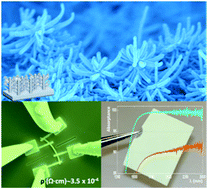
Abstract
The eventual exploitation of one-dimensional nanomaterials needs the development of scalable, high yield, homogeneous and environmentally friendly methods capable of meeting the requirements for fabrication of functional nanomaterials with properties on demand. In this article, we demonstrate a vacuum and plasma one-reactor approach for the synthesis of fundamental common elements in solar energy and optoelectronics, i.e. the transparent conducting electrode but in the form of nanotube and nanotree architectures. Although the process is generic and can be used for a variety of TCOs and wide-bandgap semiconductors, we focus herein on indium doped tin oxide (ITO) as the most previously researched in previous applications. This protocol combines widely applied deposition techniques such as thermal evaporation for the formation of organic nanowires serving as 1D and 3D soft templates, deposition of polycrystalline layers by magnetron sputtering, and removal of the templates by simply annealing under mild vacuum conditions. The process variables are tuned to control the stoichiometry, morphology, and alignment of the ITO nanotubes and nanotrees. Four-probe characterization reveals the improved lateral connectivity of the ITO nanotrees and applied on individual nanotubes shows resistivities as low as 3.5 +/- 0.9 x 10(-4) omega cm, a value comparable to that of single-crystalline counterparts. The assessment of diffuse reflectance and transmittance in the UV-Vis range confirms the viability of the supported ITO nanotubes as random optical media working as strong scattering layers. Their further ability to form ITO nanotrees opens a path for practical applications as ultra-broadband absorbers in the NIR. The demonstrated low resistivity and optical properties of these ITO nanostructures open a way for their use in LEDs, IR shields, energy harvesting, nanosensors, and photoelectrochemical applications.
Agosto, 2021 · DOI: 10.1039/d1nr01937f
Nanotecnología en Superficies y Plasma
Laser-induced scanning transfer deposition of silver electrodes on glass surfaces: A green and scalable technology
Molina, R; Ertugrul, M; Larrea, A; Navarro, R; Rico, V; Yubero, F; Gonzalez-Elipe, AR: De la Fuente, GF; Angurel, LAApplied Surface Science, 556 (2021) 149673 DOI: 10.1016/j.apsusc.2021.149673

Abstract
A pulsed laser ablation backwriting technique with high repetitive rates is implemented for the fabrication of silver coatings on glass surfaces. This method enables geometrical constraint-free deposition of metallic coatings. These exhibit sufficiently low electrical resistance to be used as electrodes in dielectric barrier discharge (DBD) plasma elements. Ambient air deposition of metallic silver electrodes on standard glass slides is explored using a sub-ns UV laser source, combined with hybrid beam scanning methods. The green nature of the overall deposition process includes a preliminary irradiation scan to homogenise the target surface before the subsequent backwriting step. Metal transfer is achieved by combining two phenomena within a simple beam scanning process: LIRT (laserinduced reverse transfer) of silver from the target to the glass, with a partial and secondary LIFT (Laser-Induced Forward Transfer) of silver from the glass to the target. Appropriate selection of pulse energy and pulse repetition rates, beam scanning velocities and target motion enable the growth of sufficiently thick Ag deposits on glass with the required low electrical resistivity and nearly 2D constraint-free geometry. This method avoids the use of vacuum and liquids, resulting in a cheap, facile and green methodology for the deposition of silver electrodes onto transparent substrate surfaces.
Agosto, 2021 · DOI: 10.1016/j.apsusc.2021.149673
Fotocatálisis Heterogénea: Aplicaciones
ZnO/Ag3PO4 and ZnO–Malachite as Effective Photocatalysts for the Removal of Enteropathogenic Bacteria, Dyestuffs, and Heavy Metals from Municipal and Industrial Wastewater
Murcia, JJ; Hernández Miño, JS; Rojas, H; Brijaldo, MH; Martin-Gómez, AN; Sánchez-Cid, P; Navío, JA; Hidalgo, MC; Jaramillo-Pérez, CWater, 13 (2021) 2264 DOI: 10.3390/w13162264

Abstract
Different composites based on ZnO/Ag3PO4 and ZnO–malachite (Cu2(OH)2CO3) were synthesized in order to determine their effectiveness in the treatment of municipal and industrial wastewaters (mainly polluted by enteropathogenic bacteria, dyes, and heavy metals). The addition of Ag3PO4 and malachite did not significantly modify the physicochemical properties of ZnO; however, the optical properties of this oxide were modified as a result of its coupling with the modifiers. The modification of ZnO led to an improvement in its effectiveness in the treatment of municipal and industrial wastewater. In general, the amount of malachite or silver phosphate and the effluent to be treated were the determining factors in the effectiveness of the wastewater treatment. The highest degree of elimination of bacteria from municipal wastewater and discoloration of textile staining wastewater were achieved by using ZnO/Ag3PO4 (5%), but an increase in the phosphate content had a detrimental effect on the treatment. Likewise, the highest Fe and Cu photoreduction from coal mining wastewater was observed by using ZnO–malachite (2.5%) and ZnO/Ag3PO4 (10%), respectively. Some of the results of this work were presented at the fourth Congreso Colombiano de Procesos Avanzados de Oxidación (4CCPAOx).
Agosto, 2021 · DOI: 10.3390/w13162264
Materiales Ópticos Multifuncionales
Light-Harvesting Properties of a Subphthalocyanine Solar Absorber Coupled to an Optical Cavity
Esteso, V; Calio, L; Espinos, H; Lavarda, G; Torres, T; Feist, J; Garcia-Vidal, FJ; Bottari, G; Míguez, HSOLAR RRL, (2021) 2100308 DOI: 10.1002/solr.202100308
Abstract
Herein, both from the experimental and theoretical point of view, the optical absorption properties of a subphthalocyanine (SubPc), an organic macrocycle commonly used as a sunlight harvester, coupled to metallic optical cavities are analyzed. How different electronic transitions characteristic of this compound and specifically those that give rise to excitonic (Q band) and charge transfer (CT band) transitions couple to optical cavity modes is investigated. It is observed that whereas the CT band couples weakly to the cavity, the Q band transitions show evidence of hybridization with the photon eigenstates of the resonator, a distinctive trait of the strong coupling regime. As a result of the different coupling regimes of the two electronic transitions, very different spectral and directional light-harvesting features are observed, which for the weakly coupled CT transitions are mainly determined by the highly dispersive cavity modes and for the strongly coupled Q band by the less angle-dependent exciton-polariton bands. Modeling also allows discriminating parasitic from productive absorption in each case, enabling the estimation of the expected losses in a solar cell acting as an optical resonator.
Julio, 2021 · DOI: 10.1002/solr.202100308
Materiales y Procesos Catalíticos de Interés Ambiental y Energético
Mechanistic Considerations on the H-2 Production by Methanol Thermal-assisted Photocatalytic Reforming over Cu/TiO2 Catalyst
Platero, F; Lopez-Martin, A; Caballero, A; Colon, GCHEMCATCHEM, 13 (2021) 3878-3888 DOI: 10.1002/cctc.202100680
Abstract
We have studied the gas phase H-2 production by methanol thermo-photoreforming using Cu-modified TiO2. Metal co-catalyst has been deposited by means of photodeposition method. The concentration of methanol in the steam was also considered. It appears that H-2 production is notably higher as temperature increases. Moreover, the optimum H-2 yield is achieved using methanol concentration of 10 % v/v. CO and CO2 were monitored as side products of the overall reaction. It has been stated that CO evolution is significant at lower temperatures. As temperature increases, CO evolution is hindered and H-2 appeared boosted. We have demonstrated that other reactions such water-gas-shift or formate dehydration would participate in the overall process. On this basis, optimal operational condition for H-2 production is attained for thermo-photocatalytic reforming of methanol solution 10 % v/v at 200 degrees C.
Julio, 2021 · DOI: 10.1002/cctc.202100680
Materiales Ópticos Multifuncionales
Ligand-Free MAPbI(3) Quantum Dot Solar Cells Based on Nanostructured Insulating Matrices
Rubino, A; Calio, L; Calvo, ME; Miguez, HSOLAR RRL (2021) 2100204 DOI: 10.1002/solr.202100204
Abstract
The stability, either chemical or thermal, and performance of colloidal quantum dot (CQD) devices are typically limited by the presence of surface-bonded organic ligands required to stabilize the nanocrystals. In addition, optimization of charge transport implies lengthy ligand exchange processing. Herein, evidence of efficient charge transport through a network of ligand-free perovskite quantum dots (PQDs) embedded in an insulating porous matrix made of monodisperse SiO2 nanoparticles is shown. Methylammonium lead iodide (CH3NH3PbI3 or MAPbI(3)) QDs are prepared in situ by infiltration of precursors within the matrix pores, which act both as nanoreactors for the synthetic reaction and as supporting scaffolds, hence reducing the number of synthetic and postprocessing steps usually required in CQD solar cells. Above a certain nanocrystal load, charge percolation is reached and dot-to-dot transport achieved without compromising quantum confinement effects. Solar cells based on MAPbI(3) QDs prepared in this way present a 9.3% efficiency, the highest reported for a scaffold-supported PQD solar cell, and significantly improved stability under solar illumination with respect to their bulk counterparts. Therefore, adequately designed networks of ligand-free PQDs can be used as both light harvesters and photocarrier conductors, in an alternative configuration to that used in previously developed QD solar cells.
Julio, 2021 · DOI: 10.1002/solr.202100204
Química de Superficies y Catálisis
Bimetallic Ni-Ru and Ni-Re Catalysts for Dry Reforming of Methane: Understanding the Synergies of the Selected Promoters
Moreno, AA; Ramirez-Reina, T; Ivanova, S; Roger, AC; Centeno, MA; Odriozola, JAFrontiers in Chemistry, 9 (2021) 694976 DOI: 10.3389/fchem.2021.694976
Abstract
Designing an economically viable catalyst that maintains high catalytic activity and stability is the key to unlock dry reforming of methane (DRM) as a primary strategy for biogas valorization. Ni/Al2O3 catalysts have been widely used for this purpose; however, several modifications have been reported in the last years in order to prevent coke deposition and deactivation of the samples. Modification of the acidity of the support and the addition of noble metal promoters are between the most reported strategies. Nevertheless, in the task of designing an active and stable catalyst for DRM, the selection of an appropriate noble metal promoter is turning more challenging owing to the lack of homogeneity of the different studies. Therefore, this research aims to compare Ru (0.50 and 2.0%) and Re (0.50 and 2.0%) as noble metal promoters for a Ni/MgAl2O4 catalyst under the same synthesis and reaction conditions. Catalysts were characterized by XRF, BET, XRD, TPR, hydrogen chemisorption (H2-TPD), and dry reforming reaction tests. Results show that both promoters increase Ni reducibility and dispersion. However, Ru seems a better promoter for DRM since 0.50% of Ru increases the catalytic activity in 10% and leads to less coke deposition.
Julio, 2021 · DOI: 10.3389/fchem.2021.694976
Química de Superficies y Catálisis
Current scenario and prospects in manufacture strategies for glass, quartz, polymers and metallic microreactors: A comprehensive review
Dominguez, MI; Centeno, MA; Martinez, TM; Bobadilla, LF; Laguna, OH; Odriozola, JAChemical Engineering Research & Design, 171 (2021) 13-35 DOI: 10.1016/j.cherd.2021.05.001

Abstract
One of the most remarkable benefits of the microreactors is the achievement of more efficient processes by enhancing the heat and mass transfer phenomena, which is the key factor for processes intensification in chemical reactions, resulting in higher conversion, selectivity and yield towards desired products. Currently, the entire scenario of microreaction approach is an emergent technology and further advances are ongoing. Several strategies have been successfully applied for structuring processes that imply the fixation of the catalysts on the microreactors. However, there are features such as the physicochemical stability of the coatings under reaction conditions that must be improved, motivating the search for new protocols. This review provides a general overview of the most important methodologies applied for glass, quartz, polymers and metals microreactors manufacture and for their coating, analyzing the advantages and drawbacks of every procedure. Furthermore, an outline of the novel insights based on additive manufacturing techniques are described.
Julio, 2021 · DOI: 10.1016/j.cherd.2021.05.001
Nanotecnología en Superficies y Plasma
Characterizing the physicochemical and mechanical properties of ZrN thin films deposited on Zr substrates by pulsed laser technique
Ghemras, I; Abdelli-Messaci, S; Alili, B; Gonzalez-Elipe, AR; Rico, VJ; Izerrouken, M; Khereddine, AY; Hadj-Larbi, FEuropean Physical Journal-Applied Physics, 95 (2021) 10301 DOI: 10.1051/epjap/2021210064
Abstract
Due to their outstanding physical and mechanical features, ZrN thin films are increasingly used as coatings to protect materials intended for nuclear applications such as Zirconium. To our knowledge, there is no report of pulsed laser deposition (PLD) of ZrN thin films on a Zr substrate. In this work, we have successfully prepared ZrN thin films on Zr substrates using the PLD technique with a KrF excimer laser, in a N-2 environment at 2 Pa pressure and a fixed substrate temperature of 500 degrees C. The deposited 200 nm ZrN thin films exhibited a homogeneous surface and showed a face-centered cubic polycrystalline structure. The surface roughness was 3.69 nm. X-ray diffraction, Raman and X-ray photoelectron spectroscopy measurements confirmed the presence of ZrN. The coated sample's mean value of hardness (11.6 GP) doubled that of the uncoated sample.
Julio, 2021 · DOI: 10.1051/epjap/2021210064
Química de Superficies y Catálisis
How a small modification in the imidazolium-based SDA can determine the zeolite structure? MFI vs. TON
Megias-Sayago, C; Blanes, JMM; Szyja, BM; Odriozola, JA; Ivanova, SMicroporous and Mesoporous Materials, 322 (2021) 111160 DOI: 10.1016/j.micromeso.2021.111160

Abstract
The present study proposes an important contribution to the understanding of ionic liquid role as structure directing agent for zeolite synthesis. A series of imidazolium based ionic liquids are used for this purpose. While the anionic counterpart influences the micellar organization during the synthesis, the imidazolium cation clearly directs the structure to one or another zeolite family as a function of its substituents and their interaction with the zeolite framework. The experimental observations are contrasted with molecular modeling explaining the distinct zeolite families obtained on the basis of different preferential orientation of the ionic liquids to the Si33 precursor.
Julio, 2021 · DOI: 10.1016/j.micromeso.2021.111160
Reactividad de Sólidos
Tuning the excitation wavelength of luminescent Mn2+-doped ZnSxSe1-x obtained by mechanically induced self-sustaining reaction
Aviles, MA; Gotor, FJOptical Materials, 117 (2021) 111121 DOI: 10.1016/j.optmat.2021.111121
Abstract
Mn2+-doped ZnSxSe1-x solid solution samples (Mn:ZnSxSe1-x) were synthesized by the mechanochemical process denoted as mechanically-induced self-sustaining reaction from Mn/Zn/S/Se powder elemental mixtures. The samples were characterized by X-ray diffraction, scanning electron microscopy, diffuse reflectance UV-Vis spectroscopy and emission and excitation photoluminescence measurements. The band-gap energy of samples was controlled by changing the stoichiometry, x, of the solid solution. All samples showed the characteristic Mn2+ 4T1-6A1 emission at -588 nm when exciting the host material, so it was possible to tune the excitation wavelength from 349 nm to 467 nm. However, an efficiency loss was observed with increasing Se content, probably due to the overlap between the absorption and emission spectra that induced self-absorption and emission quenching.
Julio, 2021 · DOI: 10.1016/j.optmat.2021.111121
Archeometric characterization (physical-chemical and microstructural) of tiles in the Mudejar Palace of the Royal Alcazar of Seville using non-invasive quantitative chemical methods
Perez-Rodriguez, JL; Robador, MD; Castaing, J; de Viguerie, L; Garrote, MA; Pleguezuelo, ABoletin de la Sociedad Española de Ceramica y Vidrio, 60 (2021) 211-228 DOI: 10.1016/j.bsecv.2020.03.001
Abstract
The Palaces in the Alcazar of Seville, Spain, are famous for their ceramic decoration. The technique of tessellation was used extensively in all rooms in the Mudejar Palace, dated in the fourteenth century. These glazed ceramics have been analysed in situ using noninvasive quantitative chemical methods of X-ray fluorescence and diffraction (XRF and XRD). Micro-samples were taken to prepare cross-sections and analysed by optical and electronic microscopy. The composition of these ceramics, their manufacturing technique and the time of application in the different areas of the Palace have been characterized in this work. Five colours have been found in the glazed ceramics: green, black, molasses, white and blue. Fe, Co, Cu, Mn and Sn are the main chemical elements responsible for the colour of the glass phase of these ceramics. Wollastonite, quartz, bustamite and feldspars inclusions have been found in the glass phase. Casiterite and Malayaite have been also characterized by XRD. The ceramic paste used for manufacturing was calcic and was heated at about 900 degrees C. Thenardite, gypsum, sodium chloride and nitrogen compounds have been characterized in the ceramic and are responsible for their alteration. The information obtained in the 24 zones studied shows that there is no homogeneity in the ceramics due to the different times in which the tiles were placed and the restorations carried out over time. There are 3 main groups of ceramics: a) probably from 14th century, b), probably from 15-16th centuries and c) from 19-20th centuries and recent restorations.
Julio, 2021 · DOI: 10.1016/j.bsecv.2020.03.001
Materiales Ópticos Multifuncionales
Self-preserving ice layers on CO2 clathrate particles: Implications for Enceladus, Pluto, and similar ocean worlds
Bostrom, M; Esteso, V; Fiedler, J; Brevik, I; Buhmann, SY; Persson, C; Carretero-Palacios, S; Parsons, DF; Corkey, RWAstronomy & Astrophysics, 650 (2021) A54 DOI: 10.1051/0004-6361/202040181
Abstract
Context. Gas hydrates can be stabilised outside their window of thermodynamic stability by the formation of an ice layer - a phenomenon termed self-preservation. This can lead to a positive buoyancy for clathrate particles containing CO2 that would otherwise sink in the oceans of Enceladus, Pluto, and similar oceanic worlds.Aims. Here we investigate the implications of Lifshitz forces and low occupancy surface regions on type I clathrate structures for their self-preservation through ice layer formation, presenting a plausible model based on multi-layer interactions through dispersion forces.Methods. We used optical data and theoretical models for the dielectric response for water, ice, and gas hydrates with a different occupancy. Taking this together with the thermodynamic Lifshitz free energy, we modelled the energy minima essential for the formation of ice layers at the interface between gas hydrate and liquid water.Results. We predict the growth of an ice layer between 0.01 and 0.2 mu m thick on CO, CH4, and CO2 hydrate surfaces, depending on the presence of surface regions depleted in gas molecules. Effective hydrate particle density is estimated, delimiting a range of particle size and compositions that would be buoyant in different oceans. Over geological time, the deposition of floating hydrate particles could result in the accumulation of kilometre-thick gas hydrate layers above liquid water reservoirs and below the water ice crusts of their respective ocean worlds. On Enceladus, the destabilisation of near-surface hydrate deposits could lead to increased gas pressures that both drive plumes and entrain stabilised hydrate particles. Furthermore, on ocean worlds, such as Enceladus and particularly Pluto, the accumulation of thick CO2 or mixed gas hydrate deposits could insulate its ocean against freezing. In preventing freezing of liquid water reservoirs in ocean worlds, the presence of CO2-containing hydrate layers could enhance the habitability of ocean worlds in our Solar System and on the exoplanets and exomoons beyond.
Junio, 2021 · DOI: 10.1051/0004-6361/202040181
Materiales de Diseño para la Energía y Medioambiente
New Trends in Nanoclay-Modified Sensors
Pavon, E; Martin-Rodriguez, R; Perdigon, AC; Alba, MDInorganics, 9 (2021) 43 DOI: 10.3390/inorganics9060043

Abstract
Nanoclays are widespread materials characterized by a layered structure in the nano-scale range. They have multiple applications in diverse scientific and industrial areas, mainly due to their swelling capacity, cation exchange capacity, and plasticity. Due to the cation exchange capacity, nanoclays can serve as host matrices for the stabilization of several molecules and, thus, they can be used as sensors by incorporating electroactive ions, biomolecules as enzymes, or fluorescence probes. In this review, the most recent applications as bioanalyte sensors are addressed, focusing on two main detection systems: electrochemical and optical methods. Particularly, the application of electrochemical sensors with clay-modified electrodes (CLME) for pesticide detection is described. Moreover, recent advances of both electrochemical and optical sensors based on nanoclays for diverse bioanalytes' detection such as glucose, H2O2, organic acids, proteins, or bacteria are also discussed. As it can be seen from this review, nanoclays can become a key factor in sensors' development, creating an emerging technology for the detection of bioanalytes, with application in both environmental and biomedical fields.
Junio, 2021 · DOI: 10.3390/inorganics9060043
Fotocatálisis Heterogénea: Aplicaciones
Features of coupled AgBr/WO3 materials as potential photocatalysts
Puga, F.; Navío, J.A.; Hidalgo, M.C.Journal of Alloys and Compounds, 867 (2021) 159191 DOI: 10.1016/j.jallcom.2021.159191
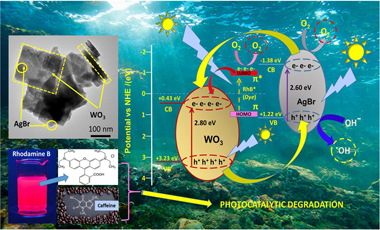
Abstract
AgBr/WO3 composite photocatalysts with different selected molar AgBr/WO3 ratios were prepared and widely characterized by XRD, N2-adsorption, SEM, TEM, UV–visible/DRS and XPS techniques. The samples were tested using rhodamine B (RhB) or caffeine, under two illumination conditions (UV and visible light). Although AgBr and WO3 pristine materials have relatively low band gap values (2.6 eV and 2.8 eV, respectively), they exhibit low or no photocatalytic activity under visible light, at least for caffeine degradation. This fact may be mainly related to a high recombination rate of photogenerated charge carriers in these samples. However, the coupling of both leads to a substantial improvement in the degradation of caffeine and RhB under both UV and visible lighting conditions. The increased photocatalytic activity found in the coupled systems with respect to the pristine materials can be attributed to the formation of a type II heterostructure in the coupled AgBr/WO3 samples. Our results show that for AgBr/WO3 coupled systems, kinetic degradation profiles have clear dependence on the molar percentages of the coupled pristine materials, as well as on the nature (sensitizing or not sensitizing effect) of the substrate. For caffeine photodegradation, the best performance was obtained when AgBr/WO3(10–15%) catalysts were used. The AgBr/WO3(20%) sample showed the best photocatalytic activity for rhodamine B degradation, exhibiting also excellent dark adsorption capacity (40–45%). Additionally, studies of activity in five consecutive tests showed a good RhB degradation during the successive reuses being involving a N-de-ethylation mechanism with the main O2•− radicals participation; relatively low mineralization percentages were observed, both under UV and visible light conditions. In these successive runs, no silver leaching to the medium was observed but a change from AgBr towards Ag2CO3 and/or AgxO was produced at the catalyst surface. These features should be known in the use of these systems as potential photocatalysts for practical applications.
Junio, 2021 · DOI: 10.1016/j.jallcom.2021.159191
Materiales de Diseño para la Energía y Medioambiente
Swelling layered minerals applications: A solid state NMR overview
Pavon, E; Alba, MDProgress in Nuclear Magnetic Resonance Spectroscopy, 124 (2021) 99-128 DOI: 10.1016/j.pnmrs.2021.04.001

Abstract
Swelling layered clay minerals form an important sub-group of the phyllosilicate family. They are characterized by their ability to expand or contract in the presence or absence of water. This property makes them useful for a variety of applications, ranging from environmental technologies to heteroge-neous catalysis, and including pharmaceutical and industrial applications. Solid State Nuclear Magnetic Resonance (SS-NMR) has been extensively applied in the characterization of these materials, providing useful information on their dynamics and structure that is inaccessible using other characterization methods such as X-ray diffraction. In this review, we present the key contributions of SS-NMR to the understanding of the mechanisms that govern some of the main applications associated to swelling clay minerals. The article is divided in two parts. The first part presents SS-NMR conventional applications to layered clay minerals, while the second part comprises an in-depth review of the information that SS-NMR can provide about the different properties of swelling layered clay minerals.
Junio, 2021 · DOI: 10.1016/j.pnmrs.2021.04.001
Química de Superficies y Catálisis
Dehydration of glucose to 5-Hydroxymethlyfurfural on bifunctional carbon catalysts
Bounoukta, CE; Megias-Sayago, C; Ammari, F; Ivanova, S; Monzon, A; Centeno, MA; Odriozola, JAApplied Catalysis B-Environmental, 286 (2021) 119938 DOI: 10.1016/j.apcatb.2021.119938
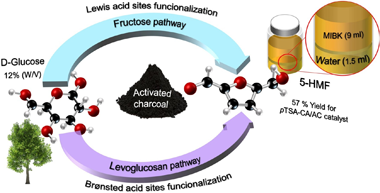
Abstract
The proposed study tries to reply on one important question concerning glucose dehydration: What is the role of bare or tandem Lewis/Bronsted acid sites in the reaction and which are better? A series of mono and bifunctional catalyst are designed and screened for the glucose dehydration reaction. The results clearly reveal that catalyst activity is a function of catalyst composition. The presence of Lewis sites the reaction toward first step isomerization, while the Brunsted acid dehydrate directly glucose to HMF via levoglucosane intermediate. This study proposed also a kinetic modelling of the included reactions and their contrast with the empirical observations.
Junio, 2021 · DOI: 10.1016/j.apcatb.2021.119938
Materiales Ópticos Multifuncionales - Materiales Coloidales
Highly Versatile Upconverting Oxyfluoride-Based Nanophosphor Films
Ngo, TT; Cabello-Olmo, E; Arroyo, E; Becerro, AI; Ocana, M; Lozano, G; Miguez, HACS Applied Materials & Interfaces, 13 (2021) 30051-30060 DOI: 10.1021/acsami.1c07012

Abstract
Fluoride-based compounds doped with rare-earth cations are the preferred choice of materials to achieve efficient upconversion, of interest for a plethora of applications ranging from bioimaging to energy harvesting. Herein, we demonstrate a simple route to fabricate bright upconverting films that are transparent, self-standing, flexible, and emit different colors. Starting from the solvothermal synthesis of uniform and colloidally stable yttrium fluoride nanoparticles doped with Yb3+ and Er3+, Ho3+, or Tm3+, we find the experimental conditions to process the nanophosphors as optical quality films of controlled thickness between few hundreds of nanometers and several micrometers. A thorough analysis of both structural and photophysical properties of films annealed at different temperatures reveals a tradeoff between the oxidation of the matrix, which transitions through an oxyfluoride crystal phase, and the efficiency of the upconversion photoluminescence process. It represents a significant step forward in the understanding of the fundamental properties of upconverting materials and can be leveraged for the optimization of upconversion systems in general. We prove bright multicolor upconversion photoluminescence in oxyfluoride-based phosphor transparent films upon excitation with a 980 nm laser for both rigid and flexible versions of the layers, being possible to use the latter to coat surfaces of arbitrary shape. Our results pave the way toward the development of upconverting coatings that can be conveniently integrated in applications that demand a large degree of versatility.
Junio, 2021 · DOI: 10.1021/acsami.1c07012
Reactividad de Sólidos
Paving the Way to Establish Protocols: Modeling and Predicting Mechanochemical Reactions
Gil-Gonzalez, E; Perez-Maqueda, LA; Sanchez-Jimenez, PE; Perejon, AJournal of Physical Chemistry Letters, 12 (2021) 5540-5546 DOI: 10.1021/acs.jpclett.1c01472
Abstract
Parametrization of mechanochemical reactions, or relating the evolution of the reaction progress to the supplied input power, is required both to establish protocols and to gain insight into mechanochemical reactions. Thus, results could be compared, replicated, or scaled up even under different milling conditions, enlarging the domains of application of mechanochemistry. Here, we propose a procedure that allows the parametrization of mechanochemical reactions as a function of the supplied input power from the direct analysis of the milling experiments in a model-free approach, where neither the kinetic model function nor the rate constant equation are previously assumed. This procedure has been successfully tested with the mechanochemical reaction of CH3NH3PbCl3, enabling the possibility to make predictions regardless of the milling device as well as gaining insight into the reaction dynamic. This methodology can work for any other mechanical reaction and definitely paves the way to establish mechanochemistry as a standard synthetic procedure.
Junio, 2021 · DOI: 10.1021/acs.jpclett.1c01472
Química de Superficies y Catálisis
Stepping toward Efficient Microreactors for CO2 Methanation: 3D-Printed Gyroid Geometry
Baena-Moreno, FM; Gonzalez-Castano, M; de Miguel, JCN; Miah, KUM; Ossenbrink, R; Odriozola, J.A.ACS Sustainable Chemistry & Engineering, 9 (2021) 8198-8206 DOI: 10.1021/acssuschemeng.1c01980
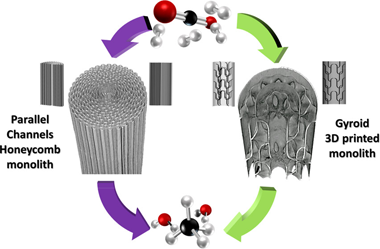
Abstract
This work presents a comparative study toward the development of efficient microreactors based on three-dimensional (3D)-printed structures. Thus, the study evaluates the influence of the metal substrate geometry on the performance of structured catalysts for the CO2 methanation reaction. For this purpose, the 0.5%Ru-15%Ni/MgAl2O4 catalyst is washcoated over two different micromonolithic metal substrates: a conventional parallel channel honeycomb structure and a novel 3D-printed structure with a complex gyroid geometry. The effect of metal substrate geometry is analyzed for several CO2 sources including ideal flue gas atmospheres and the presence of residual CH4 and CO in the flue gas, as well as simulated biogas sources. The advantages of the gyroid 3D complex geometries over the honeycomb structures are shown for all evaluated conditions, providing in the best-case scenario a 14% improvement in CO2 conversion. Moreover, this contribution shows that systematically tailoring geometrical features of structured catalysts becomes an effective strategy to achieve improved catalyst performances independent of the flue gas composition. By enhancing the transport processes and the gas-catalyst interactions, the employed gyroid 3D metal substrates enable boosted CO2 conversions and greater CH4 selectivity within diffusion-controlled regimes.
Junio, 2021 · DOI: 10.1021/acssuschemeng.1c01980
Química de Superficies y Catálisis
In-situ HDO of guaiacol over nitrogen-doped activated carbon supported nickel nanoparticles
Jin, Wei; Pastor-Perez, Laura; Villora-Pico, Juan J.; Mercedes Pastor-Blas, M.; Odriozola, Jose A.; Sepulveda-Escribano, Antonio; Ramirez Reina, TomasApplied Catalysis A-General, 620 (2021) 118033 DOI: 10.1016/j.apcata.2021.118033
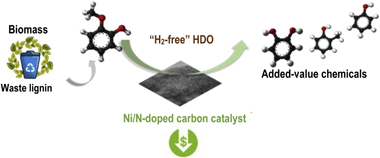
Abstract
In-situ hydrodeoxygenation of guaiacol over Ni-based nitrogen-doped activated carbon supported catalysts is presented in this paper as an economically viable route for bio-resources upgrading. The overriding concept of this paper is to use water as hydrogen donor for the HDO reaction, suppressing the input of external highpressure hydrogen. The effect of nitrogen sources, including polypyrrole (PPy), polyaniline (PANI) and melamine (Mel) on the structural, electronic and ultimately of catalytic features of the designed materials have been addressed. Nitrogen-doped samples are more active than the undoped counterparts in the "H2-free" HDO process. For instance, the conversion of guaiacol increased by 8 % for Ni/PANI-AC compared to that of Ni/AC catalysts. The superior performance of Ni/NC can be attributed to the acid-base properties and modified electronic properties, which favours the C-O cleavage and water activation as well as enhances dispersion of Ni particles on the catalysts' surface.
Junio, 2021 · DOI: 10.1016/j.apcata.2021.118033
Reactividad de Sólidos
Kinetic study of complex processes composed of non-independent stages: pyrolysis of natural rubber
Perejon, A; Sánchez-Jiménez, PE; García-Garrido, C; Pérez-Maqueda, LAPolymer Degradation and Stability, 188 (2021) 109590 DOI: 10.1016/j.polymdegradstab.2021.109590
Abstract
In this work, it is proposed a method for studying kinetics of complex processes composed of non-independent stages. In this method, the variable contribution of the different stages as a function of the heating schedule is taken into account. The method involves the simultaneous kinetic analysis of a set of experimental data registered under linear heating rate conditions, without any previous assumptions regarding the kinetic models followed by the stages or their corresponding activation energies.
The method has been tested with the kinetic analysis of the pyrolysis of natural rubber, since the kinetics of this process is complex and depends on temperature and heating schedule. It is demonstrated that the behavior of the experimental curves can be accurately predicted with the kinetic parameters calculated by the proposed methodology.
The kinetic analysis presented here could be applied to other complex processes as those found in pyrolysis, without the need of using oversimplified kinetic models that could yield significant errors when used in real applications.
Junio, 2021 · DOI: 10.1016/j.polymdegradstab.2021.109590
Materiales Ópticos Multifuncionales
The Role of the Atmosphere on the Photophysics of Ligand-Free Lead-Halide Perovskite Nanocrystals
Moran-Pedroso, M; Rubino, A; Calvo, ME; Espinos, JP; Galisteo-Lopez, JF; Miguez, HAdvanced Optical Materials, (2021) 2100605 DOI: 10.1002/adom.202100605
Abstract
Lead halide perovskite (LHP) nanocrystals (NCs) have gained attention over the past decade due to their outstanding optoelectronic properties, making them a suitable material for efficient photovoltaic and light emitting devices. Due to its soft nature, these nanostructures undergo strong structural changes upon irradiation, where these light-induced processes are strongly influenced by the environment. Since most processing routes for LHP NCs are based on colloidal approaches, the role of factors such as stabilizing ligands or solvents is usually hard to disentangle from the interaction of external radiation with the perovskite material. Employing a recently proposed synthetic approach, where ligand-free NCs can be grown within metal-oxide-based insulating nanoporous matrices, it has been feasible to perform a clean study of the effect of the surrounding atmosphere on the photophysical properties of perovskite NCs, avoiding the interference of protective capping layers or solvents. Simultaneous light-induced photo-activation and darkening processes are monitored and disentangled, and their relation with bulk and surface processes, respectively, demonstrated.
Junio, 2021 · DOI: 10.1002/adom.202100605
Química de Superficies y Catálisis
Ni/YMnO3 perovskite catalyst for CO2 methanation
Gonzalez-Castano, M; de Miguel, JCN; Penkova, A; Centeno, MA; Odriozola, JA; Arellano-Garcia, HApplied Materials Today, 23 (2021) 101055 DOI: 10.1016/j.apmt.2021.101055
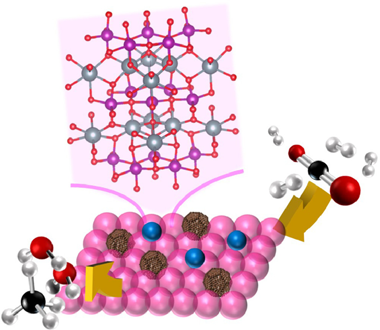
Abstract
This work proposes an innovative Ni catalyst supported over YMnO3 perovskite as a promising catalytic system for CO2 methanation reaction. Under reductive conditions, the attendance of Mn redox couples within the layered perovskite structure promotes the constitution of sub-stoichiometric YMnO3-x units which, by means of the flexible YMnO3-x reorganization capacity, results in boosted anionic mobility's. The competitive turnover frequencies (20.1 and 17.0 s(-1) at 400 degrees C under dry- and steamed- CO2 methanation conditions) displayed by Ni/YMnO3 system were related to the synergism between strongly interacting Ni particles with partially reduced YMnO3-x perovskites. The optimal Ni dispersions, for which no relevant signs of sintering issues were discerned, combined to effective role of oxygen vacancies towards the dissociative activation of CO2 molecules enabled highly active and stable catalytic behaviours with no evidence of cooking phenomena. On evaluating the water presence within CO2 methanation feedstock's, the deprived catalytic behaviour was fundamentally associated to depleted oxygen vacancies concentrations and promoted WGS side reactions.
Junio, 2021 · DOI: 10.1016/j.apmt.2021.101055
Materiales de Diseño para la Energía y Medioambiente
Pectin-cellulose nanocrystal biocomposites: Tuning of physical properties and biodegradability
Moreno, Ana Gonzalez; Guzman-Puyol, Susana; Dominguez, Eva; Benitez, Jose J.; Segado, Patricia; Lauciello, Simone; Ceseracciu, Luca; Porras-Vazquez, Jose M.; Leon-Reina, Laura; Heredia, Antonio; Heredia-Guerrero, Jose A.International Journal of Biological Macromolecules, 180 (2021) 709-717 DOI: 10.1016/j.ijbiomac.2021.03.126
Abstract
The fabrication of pectin-cellulose nanocrystal (CNC) biocomposites has been systematically investigated by blend-ing both polysaccharides at different relative concentrations. Circular free-standing films with a diameter of 9 cm were prepared by simple solution of these carbohydrates in water followed by drop-casting and solvent evaporation. The addition of pectin allows to finely tune the properties of the biocomposites. Textural characterization by AFM showed fibrous morphology and an increase in fiber diameter with pectin content. XRD analysis demonstrated that pectin incorporation also reduced the degree of crystallinity though no specific interaction between both poly-saccharides was detected, by ATR-FTIR spectroscopy. The optical properties of these biocomposites were character-ized for the first time and it was found that pectin in the blend reduced the reflectance of visible light and increased UV absorbance. Thermal stability, analyzed by TGA, was improved with the incorporation of pectin. Finally, pectin-cellulose nanocrystal biocomposites showed a good biodegradability in seawater, comparable to other common bioplastics such as cellulose and low-molecular weight polylactide, among others.
Junio, 2021 · DOI: 10.1016/j.ijbiomac.2021.03.126
Reactividad de Sólidos
Unveiling mechanochemistry: Kinematic-kinetic approach for the prediction of mechanically induced reactions
Gil-González, E.; Rodríguez-Laguna, M.d.R.; Sánchez-Jiménez, P.E.; Perejón, A.; Pérez-Maqueda, L.A.Journal of Alloys and Compounds, 866 (2021) 158925 DOI: 10.1016/j.jallcom.2021.158925
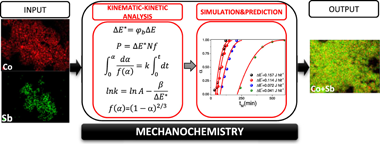
Abstract
Mechanochemistry has attracted a lot of attention over the last few decades with a rapid growth in the number of publications due to its unique features. However, very little is known about how mechanical energy is converted into chemical energy. Most of the published works using mechanochemistry neglect the required attention to the experimental parameters and their effect over the resulting products, what makes extremely difficult to reproduce the results from lab to lab. Moreover, if it is taken into consideration the broad range of experimental conditions used in different studies, it is quite difficult to compare results and set optimum conditions. As a result, mechanochemistry is generally viewed as a "black box". The aim of this work is to provide some insight into mechanochemistry. Thus, a simple kinematic-kinetic approach that allows the full parametrization of mechanically induced reactions is proposed. In an analogous way to thermally activated process, it is shown that kinetic modeling can serve to parametrize and model mechanically induced reactions as a function of the milling parameters with great reliability, thereby gaining prediction capability. As a way of example, this methodology has been applied for the first time to the mechanochemical reaction of Co and Sb to form CoSb3, a skutterudite-type thermoelectric material. Moreover, the universality of this methodology has also been validated with data from the literature. A key feature of the proposed kinematic-kinetic approach is that it can be extrapolated to other mechanically induced reactions, either inorganic or organic.
Junio, 2021 · DOI: 10.1016/j.jallcom.2021.158925
Reactividad de Sólidos
Mechanochemically synthesized ternary chalcogenide Cu3SbS4 powders in a laboratory and an industrial mill
Dutkova, E; Sayagues, MJ; Fabian, M; Balaz, M; Achimovicova, MMaterials Letters, 291 (2021) 129566 DOI: 10.1016/j.matlet.2021.129566
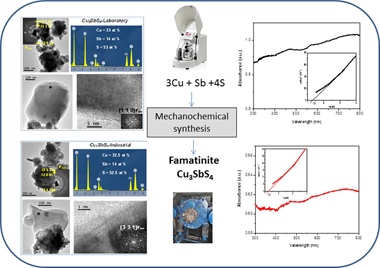
Abstract
In this work, we demonstrate the use of elemental precursors (Cu, Sb, S) to synthesize famatinite Cu3SbS4 using a laboratory planetary ball milling and an industrial eccentric vibratory milling. Cu3SbS4 was prepared for 120 min and 180 min in laboratory and industrial mill, respectively, with the utilization of protective atmosphere. The Cu3SbS4 prepared in the laboratory and industrial mill with crystallite size 14 nm and 10 nm, respectively, was confirmed by both LeBail refinement of the X-ray powder diffraction data and transmission electron microscopy. The determined band gap energy 1.31 eV and 1.24 eV is blue-shifted relative to the bulk Cu3SbS4. The synthesis of Cu3SbS4 by a scalable milling process represents a prospective route for mass production of material with potential photovoltaic properties. In this work, we demonstrate the use of elemental precursors (Cu, Sb, S) to synthesize famatinite Cu3SbS4 using a laboratory planetary ball milling and an industrial eccentric vibratory milling. Cu3SbS4 was prepared for 120 min and 180 min in laboratory and industrial mill, respectively, with the utilization of protective atmosphere. The Cu3SbS4 prepared in the laboratory and industrial mill with crystallite size 14 nm and 10 nm, respectively, was confirmed by both LeBail refinement of the X-ray powder diffraction data and transmission electron microscopy. The determined band gap energy 1.31 eV and 1.24 eV is blue-shifted relative to the bulk Cu3SbS4. The synthesis of Cu3SbS4 by a scalable milling process represents a prospective route for mass production of material with potential photovoltaic properties.
Mayo, 2021 · DOI: 10.1016/j.matlet.2021.129566
Materiales Ópticos Multifuncionales
Toward Commercialization of Stable Devices: An Overview on Encapsulation of Hybrid Organic-Inorganic Perovskite Solar Cells
Aranda, Clara A.; Calio, Laura; Salado, ManuelCrystals, 11 (2021) 519 DOI: 10.3390/cryst11050519
Abstract
Perovskite solar cells (PSCs) represent a promising technology for energy harvesting due to high power conversion efficiencies up to 26%, easy manufacturing, and convenient deposition techniques, leading to added advantages over other contemporary competitors. In order to promote this technology toward commercialization though, stability issues need to be addressed. Lately, many researchers have explored several techniques to improve the stability of the environmentally-sensitive perovskite solar devices. Challenges posed by environmental factors like moisture, oxygen, temperature, and UV-light exposure, could be overcome by device encapsulation. This review focuses the attention on the different materials, methods, and requirements for suitable encapsulated perovskite solar cells. A depth analysis on the current stability tests is also included, since accurate and reliable testing conditions are needed in order to reduce mismatching involved in reporting the efficiencies of PSC.
Mayo, 2021 · DOI: 10.3390/cryst11050519
Materiales de Diseño para la Energía y Medioambiente
Structural Evolution in Iron-Catalyzed Graphitization of Hard Carbons
Gomez-Martin, A; Schnepp, Z; Ramirez-Rico, JChemistry of Materials, 33 (2021) 3087-3097 DOI: 10.1021/acs.chemmater.0c04385
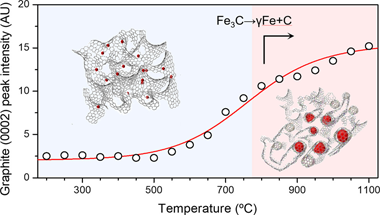
Abstract
Despite the recent interest in catalytic graphitization to obtain graphite-like materials from hard-carbon sources, many aspects of its mechanism are still poorly unknown. We performed a series of in situ experiments to study phase transformations during graphitization of a hard-carbon precursor using an iron catalyst at temperatures up to 1100 degrees C and ex situ total scattering experiments up to 2000 degrees C to study the structural evolution of the resulting graphitized carbon. Our results show that upon heating and cooling, iron undergoes a series of reductions to form hematite, magnetite, and wustite before forming a carbide that later decomposes into metallic iron and additional graphite and that the graphitization fraction increases with increasing peak temperature. Structural development with temperature results in decreasing sheet curvature and increased stacking, along with a decrease in turbostratic disorder up to 1600 degrees C. Higher graphitization temperatures result in larger graphitic domains without further ordering of the graphene sheets. Our results have implications for the synthesis of novel biomass-derived carbon materials with enhanced crystallinity.
Mayo, 2021 · DOI: 10.1021/acs.chemmater.0c04385
Materiales Avanzados
Synthesis of clay geopolymers using olive pomace fly ash as an alternative activator. Influence of the additional commercial alkaline activator used
Gomez-Casero, MA; Moral-Moral, FJ; Perez-Villarejo, L; Sanchez-Soto, PJ; Eliche-Quesada, DJournal of Materials Research and Technology-JMR&T 12 (2021) 1762-1776 DOI: 10.1016/j.jmrt.2021.03.102
Abstract
In this research, the use of olive pomace fly ash (OPFA) as an alkaline source for the activation of calcined clays (CC) from Bailen (Jaen, Spain) was studied. The optimal composition was obtained for 70 wt % CC and 30 wt % OPFA. The physical, mechanical and thermal properties of control geopolymers that use water as a liquid medium have been studied and compared with geopolymers that use additional activating solutions as sodium or potassium hydroxide solutions (8 M), or a mixture of alkaline hydroxide and alkaline silicate solution (NaOH-Na2SiO3 or KOH-K2SiO3). The results showed that OPFA can be used as an alkaline activator, showing mechanical properties slightly lower than those obtained when additional alkaline hydroxide activating solutions were used. The best compressive strength was obtained for geopolymers that use alkaline silicates as an activating solution. However, the best thermal insulation properties were obtained for control geopolymers. The microstructural characteristics of the geopolymers were evaluated by means of X-ray diffraction (XRD), Fourier transform infrared (FTIR) spectroscopy and Scanning Electron Microscopy (SEM-EDS) that corroborate the formation of geopolymeric gel in all the specimens, being the amount of gel formed greater in samples using commercial potassium activating solutions. These results demonstrate the feasibility of using this type of waste, OPFA, as activating reagents in the manufacture of geopolymers or alkaline activated materials. The manufactured geopolymers can be used as compressed earth blocks for walls and partitions, since the specimens pursue mechanical properties that comply with current regulations, presenting better thermal insulation properties.
Mayo, 2021 · DOI: 10.1016/j.jmrt.2021.03.102
Química de Superficies y Catálisis
Understanding the opportunities of metal-organic frameworks (MOFs) for CO2 capture and gas-phase CO2 conversion processes: a comprehensive overview
Gandara-Loe, J; Pastor-Perez, L; Bobadilla, LF; Odriozola, JA; Reina, TRReaction Chemistry & Engineering, 6 (2021) 787-814 DOI: 10.1039/d1re00034a

Abstract
The rapid increase in the concentration of atmospheric carbon dioxide is one of the most pressing problems facing our planet. This challenge has motivated the development of different strategies not only in the reduction of CO2 concentrations via green energy alternatives but also in the capture and conversion of CO2 into value-added products. Metal-organic frameworks (MOFs) are a relatively new class of porous materials with unique structural characteristics such as high surface areas, chemical tunability and stability, and have been extensively studied as promising materials to address this challenge. This comprehensive review identifies the specific structural and chemical properties of MOFs that result in advanced CO2 capture capacities and fairly encouraging catalytic CO2 conversion behaviour. More importantly, we describe an interconnection among the unique properties of MOFs and the engineering aspects of these intriguing materials towards CO2 capture and conversion processes.
Mayo, 2021 · DOI: 10.1039/d1re00034a
Mössbauer study of iron gall inks on historical documents
Lerf, A; Wagner, FE; Dreher, M; Espejo, T; Perez-Rodriguez, JLHeritage Science, 9 (2021) 49 DOI: 10.1186/s40494-021-00522-3
Abstract
Iron gall ink was used in the Western world as a permanent writing material already in late Roman times and throughout the Middle Ages, until it became obsolete in the twentieth century. There is much interest in experimental methods to determine the state of the ink and its degradation products on historical documents. Mossbauer spectroscopy with Fe-57 is such a method, and it has the particular advantage to be sensitive to the chemical bonding of iron, but this method has only rarely been applied to historical documents. In this paper we present Mossbauer data for two damaged documents from a Library in Granada and a handwritten German book from the eighteenth century. In addition to the inked parts of the manuscripts, ink-free parts were studied to determine the amount and chemical state of the iron in the papers. These new results are discussed in the context of previously published Mossbauer data. In one of the investigated documents Fe(II)-oxalate, FeC2O4 center dot 2H(2)O, was observed. The assignment of the various Fe3+ sites in the different documents is rather difficult and often there is a superposition of various species. Known forms of iron gallate are definitely not present on the inked papers. The observed ferric species can be remains of Fe3+ polyphenol complexes of the ink, complexes of Fe3+ with degradation products of the cellulose of the paper or gum arabic, or very small iron oxide or hydroxide nanoparticles.
Mayo, 2021 · DOI: 10.1186/s40494-021-00522-3
Tribología y Protección de Superficies - Materiales Ópticos Multifuncionales
High-temperature solar-selective coatings based on Cr(Al)N. Part 1: Microstructure and optical properties of CrNy and Cr1-xAlxNy films prepared by DC/HiPIMS
Rojas, TC; Caro, A; Lozano, G.; Sanchez-Lopez, JCSolar Energy Materials and Solar Cells, 223 (2021) 110951 DOI: 10.1016/j.solmat.2020.110951

Abstract
In order to explore the potentialities of Cr1-x(Al)xNy materials in multilayer-based solar selective coatings (SSC) for high temperature applications (T > 500 °C), the optical behavior of Cr1-x(Al)xNy films is studied in this work. Two sets of layers (CrNy and Cr1-xAlxNy) were prepared by direct current (DC) and high-power impulse magnetron sputtering (HiPIMS) technology. The deposition parameters: N2 flux, HiPIMS frequency and aluminum sputtering power, were modified to get a wide variety of stoichiometries. The composition, morphology, phases and electronic structure of the films were characterized in depth. The optical behavior was determined by UV–Vis–NIR and FTIR spectroscopies, and the optical constants were obtained from the measured transmittance and reflectance spectra based on appropriate dielectric function models. Our results indicate that small changes in the layer composition influence the optical constants. In particular, a metallic-like behavior was obtained for CrNy layers with N vacancies (CrN0.95 and CrN0.67 films) while a semiconductor-like behavior was observed for CrN1.08. Thus, the CrNy films can be used as effective absorber layer in multilayer-based SSC, and namely, the CrN0.67 film as an IR reflector/absorber layer too. Likewise, the optical properties of Cr1-xAlxNy layers can also be tuned from metallic to semiconductor-like behavior depending on the chemical composition. Indeed, the absorption coefficients of Cr1-xAlxNy films with optimized Al content and N-vacancies are comparable to those reported for state-of-the-art materials such as TiAlN or TiAlCrN. In addition, a Cr0.96Al0.04N0.89 film was found to be a suitable IR reflector/absorber layer.
Mayo, 2021 · DOI: 10.1016/j.solmat.2020.110951
Reactividad de Sólidos
Synthesis and Characterization of a Nearly Single Bulk Ti2AlN MAX Phase Obtained from Ti/AlN Powder Mixture through Spark Plasma Sintering
Salvo, C; Chicardi, E; Poyato, R; Garcia-Garrido, C; Jimenez, JA; Lopez-Pernia, C; Tobosque, P; Mangalaraja, RVMaterials, 14 (2021) 2217 DOI: 10.3390/ma14092217
Abstract
MAX phases are an advanced class of ceramics based on ternary carbides or nitrides that combine some of the ceramic and metallic properties, which make them potential candidate materials for many engineering applications under severe conditions. The present work reports the successful synthesis of nearly single bulk Ti2AlN MAX phase (>98% purity) through solid-state reaction and from a Ti and AlN powder mixture in a molar ratio of 2:1 as starting materials. The mixture of Ti and AlN powders was subjected to reactive spark plasma sintering (SPS) under 30 MPa at 1200 degrees C and 1300 degrees C for 10 min in a vacuum atmosphere. It was found that the massive formation of Al2O3 particles at the grain boundaries during sintering inhibits the development of the Ti2AlN MAX phase in the outer zone of the samples. The effect of sintering temperature on the microstructure and mechanical properties of the Ti2AlN MAX phase was investigated and discussed.
Mayo, 2021 · DOI: 10.3390/ma14092217
Química de Superficies y Catálisis
Effect of the sulphonating agent on the catalytic behavior of activated carbons in the dehydration reaction of fructose in DMSO
Bounoukta, CE; Megias-Sayago, C; Ivanova, S; Penkova, A; Ammari, F; Centeno, MA; Odriozola, JAApplied Catalysis A-General, 617 (2021) 118108 DOI: 10.1016/j.apcata.2021.118108
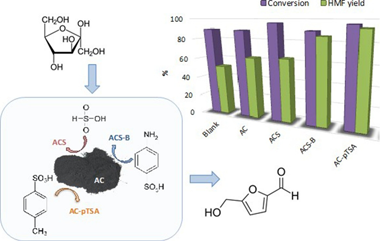
Abstract
A series of -SO3R functionalized activated carbons (R=H, O, aryl) were prepared and applied in fructose dehydration reaction to 5-hydroxymethylfurfural. Different sulphonating methods introduce groups on catalyst surface with distinct donor-acceptor and hydrophilic properties. Their nature influences significantly not only activated carbon?s textural and chemical properties but also the product yields and selectivity in fructose dehydration reaction. The viability of the solvent free reaction was also investigated and compared to the performance of the catalyst series in presence of DMSO, where the best catalytic results were obtained.
Mayo, 2021 · DOI: 10.1016/j.apcata.2021.118108
Materiales Avanzados
Effects of an Illite Clay Substitution on Geopolymer Synthesis as an Alternative to Metakaolin
Eliche-Quesada, D; Bonet-Martinez, E; Perez-Villarejo, L; Castro, E; Sanchez-Soto, PJJournal of Materials in Civil Engineering, 33 (2021) 04021072 DOI: 10.1061/(ASCE)MT.1943-5533.0003690
Abstract
In this study, a calcined illite clay from Bailen, Jaen, Spain, was valorized as a substitute of metakaolin in the synthesis of new geopolymeric materials. The raw materials, raw clay and commercial kaolin, were pretreated at 750 degrees C (4 h). Several samples (0%-100% by weight of clay) were activated by mixing NaOH solution and sodium silicate solution. The specimens were cured (60 degrees C and 99% relative humidity) for 24 h, then demolded and kept at ambient conditions for 7, 28, and 90 days. The prepared geopolymers were characterized by X-ray diffraction, Fourier transform infrared spectroscopy, and scanning electron microscopy. Physical, mechanical, and thermal properties were determined. The results indicated that the specimens based on the illite raw clay and metakaolin present an amorphous consolidated appearance, characteristic of the polycondensation reactions. The incorporation of up to 50% by weight of raw clay provided geopolymers with higher mechanical strength (39.6 MPa) and bulk density (1,455 kg/m(3)), lower apparent porosity (19.6%), and similar although slightly higher thermal conductivity (0.25 W/mK) than control geopolymers containing only metakaolin as a precursor after 28 days of curing. Control geopolymers presented compressive strength, bulk density, apparent porosity, and thermal conductivity of 23 MPa, 1,251 kg/m(3), 41.03% and 0.224 W/mk, respectively, at the same age of cured geopolymers. The mechanical properties increased with curing time due to a greater advance of the geopolymerization reaction. Therefore, this illite clay can be thermally activated together with metakaolin to obtain geopolymers with suitable technological properties. The results demonstrate that the finished materials can be used for construction applications.
Mayo, 2021 · DOI: 10.1061/(ASCE)MT.1943-5533.0003690
Química de Superficies y Catálisis
IR spectroscopic insights into the coking-resistance effect of potassium on nickel-based catalyst during dry reforming of methane
Azancot, L; Bobadilla, LF; Centeno, MA; Odriozola, JAApplied Catalysis B-Environmental, 285 (2021) 119822 DOI: 10.1016/j.apcatb.2020.119822
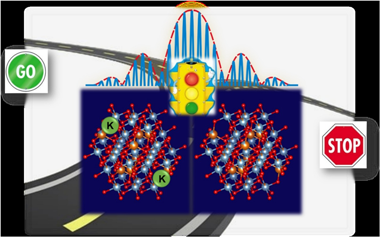
Abstract
Dry reforming of methane (DRM) is an effective catalytic route for transforming CO2 and CH4 into valuable syngas and thus potentially attractive for mitigating the emission of environmental harmful gases. Therefore, it is crucial to develop rationally Ni-based catalysts highly resistant to coking and sintering. In this scenario, the addition of small amounts of potassium to nickel catalyst increases their resistance to coking during dry reforming of methane. Nonetheless, the specific role of potassium in these catalysts not have been fully understood and there are still important discrepancies between the different reported studies. This work provides a new approach on the anticoking nature of a K-promoted Ni catalyst by means of a combined IR spectroscopic study of in situ characterization by CO adsorption under static conditions and operando DRIFTS measurements under dynamic conditions of DRM reaction. The involved surface species formed during the reaction were elucidated by transient and steady-state operando DRIFTS studies. It was revealed that the existence of Ni-K interfacial sites favours the gasification of carbonaceous deposits towards reverse Boudouard reaction and reduces the sticking probability of CO2 dissociative adsorption. Moreover, the presence of strongly Mg-O-K basic sites leads to the formation of carbonate intermediates that are subsequently reduced into CO gaseous towards the associative mechanism by RWGS reaction. These results provide a fundamental understanding of the relevant anticoking effect of potassium on Ni-based catalysts.
Mayo, 2021 · DOI: 10.1016/j.apcatb.2020.119822
Materiales para Bioingeniería y Regeneración Tisular
Nanofibrous Matrix of Defined Composition Sustains Human Induced Pluripotent Stem Cell Culture
Borrego-Gonzalez, S; de la Cerda, B; Diaz-Corrales, FJ; Diaz-Cuenca, AACS Applied Bio Materials, 4 (2021) 3035-3040 DOI: 10.1021/acsabm.0c00425

Abstract
Human induced pluripotent stem cells (hiPSCs) represent the most promising biological material for regenerative medicine applications. In this work, a 3D solid nanofibrous matrix of defined composition (Colamigel-S) consisting of 97 wt % gelatin, 2.6 wt % atelocollagen, and 0.4 wt % laminin has been reproducibly processed and characterized and exhibits a homogeneous nanofibrillar network of high surface area, interconnected microcavities, and typical D-periodic collagen fibril nanostructural features. The purpose of the study was to test the performance of Colamigel-S as substrate for in vitro hiPSCs culture, finding that these cells efficiently attach and grow keeping their characteristic stem morphology and undifferentiated state.
Abril, 2021 · DOI: 10.1021/acsabm.0c00425
Química de Superficies y Catálisis
Fructose dehydration reaction over functionalized nanographitic catalysts in MIBK/H2O biphasic system
Martin, GD; Bounoukta, CE; Ammari, F; Dominguez, MI; Monzon, A; Ivanova, S; Centeno, MACatalysis Today, 366 (2021) 68-76 DOI: 10.1016/j.cattod.2020.03.016

Abstract
A series of functionalized nanographitic carbons is prepared, characterized and tested in fructose dehydration reaction to 5-hydroxymethylfurfural. The functionalization treatment was selected to introduce various Bro?nsted acid sites and to modify the textural and catalytic properties of the initial carbon material. Within the series, the sulfonated carbons present the most interesting catalytic behavior resulting in important selectivity to the desired product once the reaction variables were properly adjusted.
Abril, 2021 · DOI: 10.1016/j.cattod.2020.03.016
Química de Superficies y Catálisis
Biogas Conversion to Syngas Using Advanced Ni-Promoted Pyrochlore Catalysts: Effect of the CH4/CO2 Ratio
le Sache, E; Moreno, AA; Reina, TRFrontiers in Chemistry, 9 (2021) 672419 DOI: 10.3389/fchem.2021.672419
Abstract
Biogas is defined as the mixture of CH4 and CO2 produced by the anaerobic digestion of biomass. This particular mixture can be transformed in high valuable intermediates such as syngas through a process known as dry reforming (DRM). The reaction involved is highly endothermic, and catalysts capable to endure carbon deposition and metal particle sintering are required. Ni-pyrochlore catalysts have shown outstanding results in the DRM. However, most reported data deals with CH4/CO2 stoichiometric ratios resulting is a very narrow picture of the overall biogas upgrading via DRM. Therefore, this study explores the performance of an optimized Ni-doped pyrochlore, and Ni-impregnated pyrochlore catalysts in the dry reforming of methane, under different CH4/CO2 ratios, in order to simulate various representatives waste biomass feedstocks. Long-term stability tests showed that the ratio CH4/CO2 in the feed gas stream has an important influence in the catalysts' deactivation. Ni doped pyrochlore catalyst, presents less deactivation than the Ni-impregnated pyrochlore. However, biogas mixtures with a CH4 content higher than 60%, lead to a stronger deactivation in both Ni-catalysts. These results were in agreement with the thermogravimetric analysis (TGA) of the post reacted samples that showed a very limited carbon formation when using biogas mixtures with CH4 content <60%, but CH4/CO2 ratios higher than 1.25 lead to an evident carbon deposition. TGA analysis of the post reacted Ni impregnated pyrochlore, showed the highest amount of carbon deposited, even with lower stoichiometric CH4/CO2 ratios. The later result indicates that stabilization of Ni in the pyrochlore structure is vital, in order to enhance the coke resistance of this type of catalysts.
Abril, 2021 · DOI: 10.3389/fchem.2021.672419
Nanotecnología en Superficies y Plasma
Form Birefringence in Resonant Transducers for the Selective Monitoring of VOCs under Ambient Conditions
Oliva-Ramirez, Manuel; Lopez-Santos, Carmen; Berthon, Hermine; Goven, Mathilde; Portoles, Jose; Gil-Rostra, Jorge; Gonzalez-Elipe, Agustin R.; Yubero, FranciscoACS Applied Materials & Interfaces, 13 (2021) 19148-19158 DOI: 10.1021/acsami.1c02499
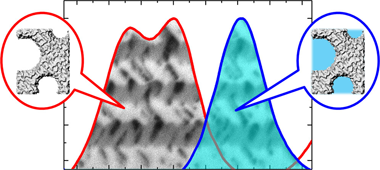
Abstract
In this work, we have developed a new kind of nanocolumnar birefringent Bragg microcavity (BBM) that, tailored by oblique angle deposition, behaves as a selective transducer of volatile organic compounds (VOCs). Unlike the atomic lattice origin of birefringence in anisotropic single crystals, in the BBM, it stems from an anisotropic self-organization at the nanoscale of the voids and structural elements of the layers. The optical adsorption isotherms recorded upon exposure of these nanostructured systems to water vapor and VOCs have revealed a rich yet unexplored phenomenology linked to their optical activity that provides both capacity for vapor identification and partial pressure determination. This photonic response has been reproduced with a theoretical model accounting for the evolution of the form birefringence of the individual layers upon vapor condensation in nanopores and internanocolumnar voids. BBMs that repel water vapor but are accessible to VOCs have been also developed through grafting of their internal surfaces with perfluorooctyltriethoxysilane molecules. These nanostructured photonic systems are proposed for the development of transducers that, operating under environmental conditions, may respond specifically to VOCs without any influence by the degree of humidity of the medium.
Abril, 2021 · DOI: 10.1021/acsami.1c02499
Reactividad de Sólidos
Enhancing the electrical conductivity of in-situ reduced graphene oxide-zirconia composites through the control of the processing routine
Lopez-Pernia, C; Morales-Rodriguez, A; Gallardo-Lopez, A; Poyato, RCeramics International, 47 (2021) 9382-9391 DOI: 10.1016/j.ceramint.2020.12.069
Abstract
Graphene oxide (GO) was mixed with 3 mol% yttria tetragonal zirconia polycrystal (3YTZP) using two powder processing routines: a colloidal method in an aqueous solution and a combination of ultrasonication with highenergy planetary ball milling in wet conditions. Highly densified 3YTZP composites with reduced GO (rGO) were consolidated by Spark Plasma Sintering. The in-situ reduction of GO was successfully achieved during the high temperature sintering process and a detailed study of the restoration of the graphene structure in the sintered composites has been made by Raman spectroscopy. Although no differences between the composites prepared by the two processing methods were found in the distribution of the rGO throughout the 3YTZP matrix for high rGO contents (i.e. the composites with 5 and 10 vol% rGO), a better distribution of the graphene phase was found in the composites with 1 and 2.5 vol% rGO prepared by planetary ball milling. This result, together with a better reduction of the GO in these composites, led to the obtaining of rGO/3YTZP composites with a better behavior in terms of electrical conductivity: an electrical percolation threshold below 2.5 vol% rGO and a high electrical conductivity value (-610 S/m for 10 vol% rGO).
Abril, 2021 · DOI: 10.1016/j.ceramint.2020.12.069
Materiales de Diseño para la Energía y Medioambiente
Organophilization of acid and thermal treated sepiolite for its application in BTEX adsorption from aqueous solutions
Varela, CF; Pazos, MC; Alba, MDJournal of Water Process Engineering, 40 (2021) 101949 DOI: 10.1016/j.jwpe.2021.101949
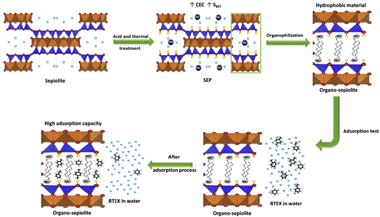
Abstract
Acid and thermal treated sepiolite was organophilized by cationic exchange with several alkylammonium cations (octylammonium, hexadecylammonium, tetradecyltrimethylammonium, and hexadecyltrimethylammonium). The adsorption capacity of BTEX from aqueous solutions was evaluated through the adsorption isotherms performed in batch. The results were analysed using three isotherm models: Freundlich, Langmuir and Dubinin-Radushkevich (D-R model). The behaviour of adsorption isotherm suggested the multilayer coverage on a heterogeneous surface, which is according to the Freundlich isotherm model. The thermodynamic analyse using the D-R model show that physical mechanisms govern the process. The maximum adsorption capacity of BTEX on the obtained materials was in the range values of 81.19 mg g(-1) - 1448.42 mg g(-)(1), which are higher than those reported up to now. The organo-sepiolite materials exhibit a high potential in the adsorption of BTEX compounds from aqueous solutions.
Abril, 2021 · DOI: 10.1016/j.jwpe.2021.101949
Nanotecnología en Superficies y Plasma
Rietveld Refinement, mu-Raman, X-ray Photoelectron, and Mossbauer Studies of Metal Oxide-Nanoparticles Growth on Multiwall Carbon Nanotubes and Graphene Oxide
Ramos-Guivar, JA; Gonzalez-Gonzalez, JC; Litterst, FJ; Passamani, ECCrystal Growth & Design, 21 (2021) 2128-2141 DOI: 10.1021/acs.cgd.0c01551
Abstract
Applying a modified coprecipitation method, maghemite and anatase nanoparticles embedded in graphene oxide and multiwall carbon nanotube frameworks were prepared, and a detailed structural characterization is presented. Transmission electron images have revealed that the multiwall carbon nanotubes and graphene oxide act as substrates to reduce the nanoparticle agglomeration with narrow sizes of ca. 9-20 nm, in agreement with the results of the Rietveld refinement, which have also indicated their crystallite apparent size and shapes using the spherical harmonics approach. In structural studies of maghemite nanoparticles by Raman spectroscopy, it was found that the effect of optical density and laser power intensity plays a significant role. When no optical filter was located between the powder sample and the laser source, a transformation from the gamma-Fe2O3 to the alpha-Fe2O3 phase was observed, as demonstrated by the disappearance of the characteristic broad Raman peak (A(1g)) of the gamma-Fe2O3 phase when increasing the laser power. X-ray photoelectron spectroscopy has also brought insights into the functionalization mechanism, suggesting that the one-pot reduction of the graphene oxide is favored by the alkaline gamma-Fe2O3 nanoparticle growth. The temperature dependence of the Fe-57 Mossbauer spectra has indicated that the effective anisotropy constant of Fe oxide-based nanoparticles is similar to that of bulk maghemite, and magnetic relaxation of Fe3+ spins depends on particle sizes.
Abril, 2021 · DOI: 10.1021/acs.cgd.0c01551
Nanotecnología en Superficies y Plasma
New Insights on the Conversion Reaction Mechanism in Metal Oxide Electrodes for Sodium-Ion Batteries
Mosa, J; Garcia-Garcia, FJ; Gonzalez-Elipe, AR; Aparicio, MNanomaterials, 11 (2021) 966 DOI: 10.3390/nano11040966

Abstract
Due to the abundance and low cost of exchanged metal, sodium-ion batteries have attracted increasing research attention for the massive energy storage associated with renewable energy sources. Nickel oxide (NiO) thin films have been prepared by magnetron sputtering (MS) deposition under an oblique angle configuration (OAD) and used as electrodes for Na-ion batteries. A systematic chemical, structural and electrochemical analysis of this electrode has been carried out. The electrochemical characterization by galvanostatic charge-discharge cycling and cyclic voltammetry has revealed a certain loss of performance after the initial cycling of the battery. The conversion reaction of NiO with sodium ions during the discharge process to generate sodium oxide and Ni metal has been confirmed by X-ray photoelectron spectra (XPS) and micro-Raman analysis. Likewise, it has been determined that the charging process is not totally reversible, causing a reduction in battery capacity.
Abril, 2021 · DOI: 10.3390/nano11040966
Nanotecnología en Superficies y Plasma
Novel procedure for studying laser-surface material interactions during scanning laser ablation cleaning processes on Cu-based alloys
Di Francia, E; Lahoz, R; Neff, D; Rico, V; Nuns, N; Angelini, E; Grassini, SApplied Surface Science, 544 (2021) art. 178820 DOI: 10.1016/j.apsusc.2020.148820

Abstract
Laser ablation is an effective method to clean Cu-based alloys. A novel procedure of characterisation was developed involving O-18 isotopes evaluated by ToF-SIMS spectroscopy to assess the driving mechanisms of laser-surface interactions. The presence of re-oxidised compounds was detected, discerning between the oxygen from the corrosion layer and the one introduced by the interaction with the laser (that was generated in a controlled atmosphere of O-18 diluted in N-2). A set of samples treated with different laser conditions were characterised by FESEM and mu Raman. The results have shown that re-oxidation phenomenon can occur and its selectivity depends on the laser conditions.
Abril, 2021 · DOI: 10.1016/j.apsusc.2020.148820
Fotocatálisis Heterogénea: Aplicaciones
Fluorinated and platinized Titania for Glycerol oxidation
Murcia, J.J.; Bautista, E; Ávila Martínez, E.G.; Rangel R.N.; Romero, R.; Cubillos Lobo, J.A.; Rojas Sarmiento, H.A.; Hernández, J.S.; Cárdenas, O.; Hidalgo, M.C.; Navío, J.A.; Baeza, R.Materials Proceedings, 4 (2021) 37 DOI: 10.3390/IOCN2020-07792
Abstract
In this research, photocatalysts based on TiO2 modified by fluorination and platinum addition were evaluated in the glycerol oxidation. These materials were characterized by different instrumental analysis techniques to determine the physicochemical properties. It was found that the surface modification lead to improve the materials absorption in the Visible region of the electromagnetic spectra and to increase the surface area of TiO2. By HPLC analysis was possible to observed that the photocatalysts 0.5% Pt-F-TiO2 showed the highest yield and selectivity towards glyceraldehyde (GAL). It was also observed that the increase in the platinum content until values of 2% had a negative effect in the effectiveness of fluorinated Titania in the glycerol photo-oxidation. The fluorination and platinum addition modify some physicochemical properties of TiO2, leading also to modify the reaction mechanism and selectivity during glycerol partial photo-oxidation and the dose of photocatalysts is an important reaction condition to obtain GAL and Dyhidroxyacetone (DHA) with yields above to 70%.
Abril, 2021 · DOI: 10.3390/IOCN2020-07792
Materiales Coloidales
Holmium phosphate nanoparticles as negative contrast agents for high-field magnetic resonance imaging: Synthesis, magnetic relaxivity study and in vivo evaluation
Gomez-Gonzalez, E; Caro, C; Martinez-Gutierrez, D; Garcia-Martin, ML; Ocana, M; Becerro, AIJournal of Colloid and Interface Science, 587 (2021) 131-140 DOI: 10.1016/j.jcis.2020.11.119
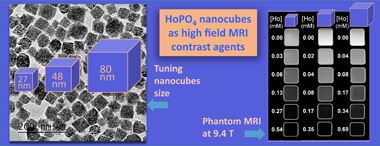
Abstract
The increasing use of high magnetic fields in magnetic resonance imaging (MRI) scanners demands new contrast agents, since those used in low field instruments are not effective at high fields. In this paper, we report the synthesis of a negative MRI contrast agent consisting of HoPO4 nanoparticles (NPs). Three different sizes (27 nm, 48 nm and 80 nm) of cube-shaped NPs were obtained by homogeneous precipitation in polyol medium and then coated with poly(acrylic) acid (PAA) to obtain stable colloidal suspensions of HoPO4@PAA NPs in physiological medium (PBS). The transverse relaxivity (r2) of aqueous suspensions of the resulting NPs was evaluated at both 1.44 T and 9.4 T. A positive correlation between r2 values and field strength as well as between r2 values and particle size at both magnetic field strengths was found although this correlation failed for the biggest NPs at 9.4 T, likely due to certain particles aggregation inside the magnet. The highest r2 value (489.91 mM-1s−1) was found for the 48 nm NPs at 9.4 T. Toxicity studies demonstrated that the latter NPs exhibited low toxicity to living systems. Finally, in vivo studies demonstrated that HoPO4@PAA NPs could be a great platform for next-generation T2-weighted MRI contrast agents at high magnetic field.
Abril, 2021 · DOI: 10.1016/j.jcis.2020.11.119
Materiales y Procesos Catalíticos de Interés Ambiental y Energético
Elucidating the nature of Mo species on ZSM-5 and its role in the methane aromatization reaction
Lopez-Martin, A.; Platero, F; Colon, G.; Caballero, A.Reaction Chemistry & Engineering DOI: 10.1039/d1re00044f

Abstract
The valorization of methane is one of the most important goals during the transition period to the general use of renewable energies. Its transformation into a valuable chemical like benzene by direct aromatization of methane (DAM) reaction has been extensively studied in the past years, mainly using Mo/ZSM-5 catalytic systems. Although viable, this DAM reaction poses a number of issues mainly derived from poor conversion and deactivation processes. Therefore, a deeper knowledge of these systems is needed. Herein, by combining chemical (TPR), spectroscopic (XPS), HAADF and other techniques, we have identified the different Mo precursors stabilized in the calcined ZSM-5 support, their nature (monomers, dimers and bulk Mo oxides), location in the zeolite framework (external surface or micropores), and the partial segregation of aluminum during the preparation of catalysts. The role of each Mo phase promoting or hindering the transformation of methane in aromatics has been also clarified.
Abril, 2021 · DOI: 10.1039/d1re00044f
Materiales de Diseño para la Energía y Medioambiente
Pb2+, Cd2+ and Hg2+ removal by designed functionalized swelling high-charged micas
Osuna, FJ; Pavon, E; Alba, MDScience of The Total Environment, 764 (2021) 142811 DOI: 10.1016/j.scitotenv.2020.142811

Abstract
The increasing accumulation of toxic heavy metals in the environment has generated the need of efficient removal systems, being the adsorption method the most popular one applied in aqueous solutions. Of particular concern is the case of Pb2+, Cd2+ and Hg2+ due to their high potential hazard. In this paper, we describe the feasibility of a new family of nanomaterials, swelling high charge micas, in the removal of these cations from aqueous solutions. Batch adsorption experiments were carried out in the as-made micas, NaMn, and after functionalization with ethylammonium, EA-Mn, and mercaptoethylammonium, MEA-Mn. The results have demonstrated that all of them are efficient heavy metal adsorbents, being Na-M2 the best adsorbent for Pb2+ and Cd2+, and, MEA-M2 for Hg2+.
Abril, 2021 · DOI: 10.1016/j.scitotenv.2020.142811
Materiales y Procesos Catalíticos de Interés Ambiental y Energético
LED-driven controlled deposition of Ni onto TiO2 for visible-light expanded conversion of carbon dioxide into C-1-C-2 alkanes
Sanz-Marco, A; Hueso, JL; Sebastian, V; Nielsen, D; Mossin, S; Holgado, JP; Bueno-Alejo, CJ; Balas, F; Santamaria, JNanoscale Advances DOI: 10.1039/d1na00021g
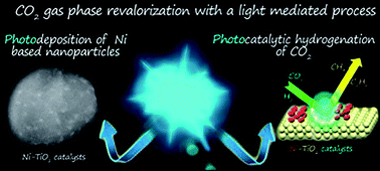
Abstract
Photocatalytic gas-phase hydrogenation of CO2 into alkanes was achieved over TiO2-supported Ni nanoparticles under LED irradiation at 365 nm, 460 nm and white light. The photocatalysts were prepared using photo-assisted deposition of Ni salts under LED irradiation at 365 nm onto TiO2 P25 nanoparticles in methanol as a hole scavenger. This procedure yielded 2 nm Ni particles decorating the surface of TiO2 with a nickel mass content of about 2%. Before the photocatalytic runs, Ni/TiO2 was submitted to thermal reduction at 400 °C in a 10% H2 atmosphere which induced O-defective TiO2−x substrates. The formation of oxygen vacancies, Ti3+ centers and metallic Ni sites upon photocatalytic CO2 hydrogenation was confirmed by operando EPR analysis. In situ XPS under reaction conditions suggested a strong metal–support interaction and the co-existence of zero and divalent Ni states. These photoactive species enhanced the photo-assisted reduction of CO2 below 300 °C to yield CO, CH4 and C2H6 as final products.
Abril, 2021 · DOI: 10.1039/d1na00021g
Nanotecnología en Superficies y Plasma
Electrochromic response and porous structure of WO3 cathode layers
Louloudakis, D; Mouratis, K; Gil-Rostra, J; Koudoumas, E; Alvarez, R; Palmero, A; Gonzalez-Elipe, ARElectrochimica Acta, 376 (2021) 138049 DOI: 10.1016/j.electacta.2021.138049
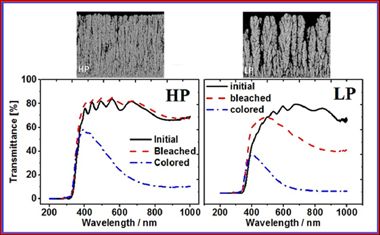
Abstract
Maximizing the electrochromic response of tungsten oxide-based systems demands highly porous electrode layers that facilitate the incorporation of electrolyte cations during the reduction process. In this work, amorphous and porous WO3 thin films were grown on indium tin dioxide glass substrates by magnetron sputtering at oblique angles at two different plasma gas pressures. Remarkably, the film that showed higher porosity presented a worse electrochromic response in terms of durability, time response and charge density capacity. This result is analyzed and explained on the basis of the features of the porous structure of the films: While the typical nanostructure developed at low pressures possesses large and connected pore voids with few ramifications, the nanostructure generated at a higher pressure presents a rather sponge-like porous structure with numerous and small well-connected voids. A general discussion on the role of the porous structure and, particularly, on the accessible pore volume and area is carried out. It is concluded that not only the accessible pore volume, defining the volume of electrolyte that stays inside the layer, but also the accessible pore area, which defines the efficiency of the incorporation/release of Li+ cations within the electrode material, determine the efficiency and reversibility of the electrochromic response.
Abril, 2021 · DOI: 10.1016/j.electacta.2021.138049
Química de Superficies y Catálisis
Cu supported Fe-SiO2 nanocomposites for reverse water gas shift reaction
Gonzalez-Castano, M; de Miguel, JCN; Sinha, F; Wabo, SG; Klepel, O; Arellano-Garcia, HJournal of CO2 Utilization, 46 (2021) 101493 DOI: 10.1016/j.jcou.2021.101493
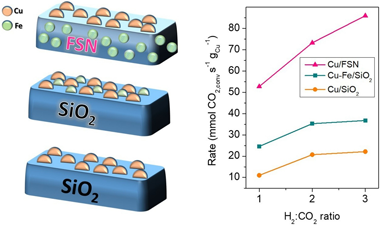
Abstract
This work analyses the catalytic activity displayed by Cu/SiO2, Cu-Fe/SiO2 and Cu/FSN (Fe-SiO2 nanocomposite) catalysts for the Reverse Water Gas Shift reaction. Compared to Cu/SiO2 catalyst, the presence of Fe resulted on higher CO?s selectivity and boosted resistances against the constitution of the deactivation carbonaceous species. Regarding the catalytic performance however, the extent of improvement attained through incorporation Fe species strongly relied on the catalysts' configuration. At 30 L/gh and H-2:CO2 ratios = 3, the performance of the catalysts? series increased according to the sequence: Cu/SiO2 < Cu-Fe/SiO2 << Cu/FSN. The remarkable catalytic enhancements provided by Fe-SiO2 nanocomposites under different RWGS reaction atmospheres were associated to enhanced catalyst surface basicity's and stronger Cu-support interactions. The catalytic promotion achieved by Fe-SiO2 nanocomposites argue an optimistic prospective for nanocomposite catalysts within future CO2-valorising technologies.
Abril, 2021 · DOI: 10.1016/j.jcou.2021.101493
- ‹ anterior
- 9 of 37
- siguiente ›














